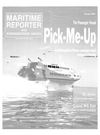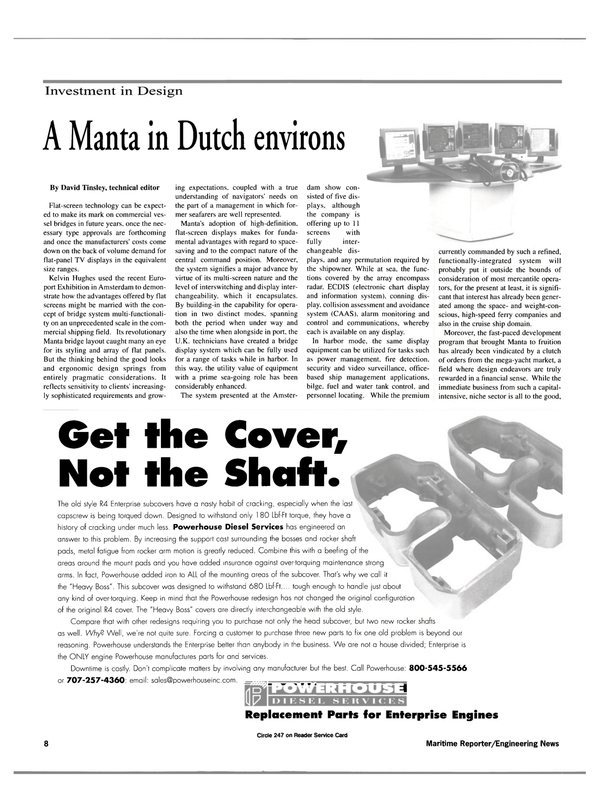
A Manta in Dutch environs
Flat-screen technology can be expected to make its mark on commercial vessel bridges in future years, once the necessary type approvals are forthcoming and once the manufacturers' costs come down on the back of volume demand for flat-panel TV displays in the equivalent size ranges.
Kelvin Hughes used the recent Europort Exhibition in Amsterdam to demonstrate how the advantages offered by flat screens might be married with the concept of bridge system multi-functionality on an unprecedented scale in the commercial shipping field. Its revolutionary Manta bridge layout caught many an eye for its styling and array of flat panels.
But the thinking behind the good looks and ergonomic design springs from entirely pragmatic considerations. It reflects sensitivity to clients' increasingly sophisticated requirements and growing expectations, coupled with a true understanding of navigators' needs on the part of a management in which former seafarers are well represented.
Manta's adoption of high-definition, flat-screen displays makes for fundamental advantages with regard to spacesaving and to the compact nature of the central command position. Moreover, the system signifies a major advance by virtue of its multi-screen nature and the level of interswitching and display interchangeability.
which it encapsulates.
By building-in the capability for operation in two distinct modes, spanning both the period when under way and also the time when alongside in port, the U.K. technicians have created a bridge display system which can be fully used for a range of tasks while in harbor. In this way. the utility value of equipment with a prime sea-going role has been considerably enhanced.
The system presented at the Amsterdam show consisted of five displays.
although the company is offering up to 11 screens with fully interchangeable displays.
and any permutation required by the shipowner. While at sea. the functions covered by the array encompass radar. ECDIS (electronic chart display and information system), conning display.
collision assessment and avoidance system (CAAS). alarm monitoring and control and communications, whereby each is available on any display.
In harbor mode, the same display equipment can be utilized for tasks such as power management, fire detection, security and video surveillance, officebased ship management applications, bilge, fuel and water tank control, and personnel locating. While the premium currently commanded by such a refined, functionally-integrated system will probably put it outside the bounds of consideration of most mercantile operators, for the present at least, it is significant that interest has already been generated among the space- and weight-conscious, high-speed ferry companies and also in the cruise ship domain.
Moreover, the fast-paced development program that brought Manta to fruition has already been vindicated by a clutch of orders from the mega-yacht market, a field where design endeavors are truly rewarded in a financial sense. While the immediate business from such a capitalintensive, niche sector is all to the good.
Read A Manta in Dutch environs in Pdf, Flash or Html5 edition of January 2000 Maritime Reporter
Other stories from January 2000 issue
Content
- Editor's Note page: 6
- A Manta in Dutch environs page: 8
- Good opening round for German contender page: 10
- Dutch small-ship prowess page: 10
- Holland America Contracts Fincantieri For Two page: 12
- Samsung Heavy Rings Up Significant Orders To Usher In New Year page: 13
- Totem Enters Into Agreement With NASSCO page: 14
- Perkins Sabre Launches Two New Engines page: 18
- Offshore Supply Vessels Rebuilt - Cargo Handling, Tank Sounding Automated page: 20
- Transas Launches Stand-Alone Engineroom Simulator page: 21
- VTC Expands Possibilities With Cutler-Hammer Agreement page: 21
- Columbia Coastal Christens Super Barge page: 22
- Pilot Boat Features New Hull Design page: 23
- Schlumberger Launches Deepwater Vessel page: 23
- Cascade Signs Maintenance/Repair Agreement page: 24
- Verolme Botlek Carries Out Vessel Upgrades page: 24
- Argent To Reactivate LNG Carrier page: 25
- United States Lines Flying High Again page: 26
- "Boutique" Cruise Vessel Keeps French Cruisers Nicely Coiffed page: 26
- SeaArk Marine's Atlantis Explorer page: 28
- HMS: Outfitting ferry for safety, success page: 29
- Passenger Vessel Report page: 30
- Austal To Start U.S. Shipbuilding Joint Venture page: 31
- Passenger Vessel Report page: 32
- Finnegan Joins Drew Marine page: 45
- The Coating Conundrum page: 46
- U.S. Builders Make Waves At Year End page: 51
- Alabama Launches ATB page: 52
- Deutz Augments Lower Power Range With New Engines page: 80
- Deere adds 8.1 L Engine to Line page: 80


